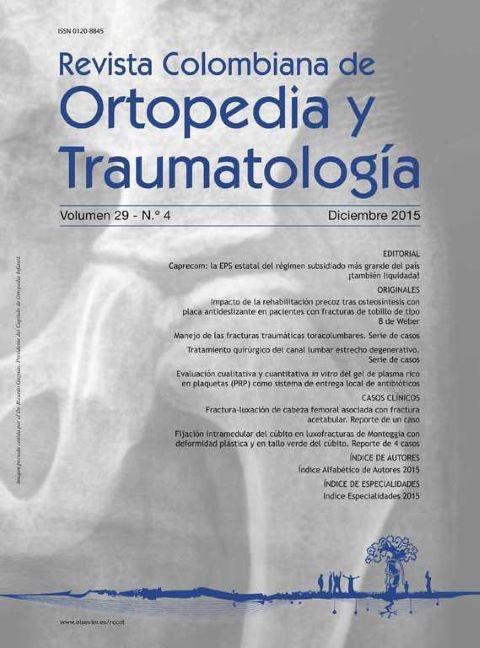Management of traumatic thoracolumbar fractures. Case series
DOI:
https://doi.org/10.1016/j.rccot.2016.02.010Keywords:
thoracolumbar fracture, load sharing Burst fractures, short instrumentation without fusionAbstract
Background: The thoracolumbar spine fractures are among the most severe injuries of the human skeleton, especially in younger patients, where they are often related to high energy trauma such as traffic accidents or falls from a great height. The objective of the study is to review our management of traumatic thoracolumbar fractures in young patients.
Materials and methods: A cases series study was performed, including review of medical records of 28 patients treated from 2008 to 2013, ranked by Magerl-AO, Load-Sharing, TLICS, conservative and surgical treatment, monitoring and radiological functional according to the scale of the SF-36.
Results: 12 men, 16 women, median follow-up of 3.1 years, mean age of 36.8 years. According Magerl-AO: A1 6 types, 12 types A3, 2 types A4, 4 types 4 types B2 and C2. According LoadSharing: 9 score greater than 6. According TLICS: 6 with less than 4 rating and 10 with the highest score to 5. Radiographically: preoperative kyphosis of 12.3º and 16.7º and the last control 9.7 and 5º for conservative and surgical respectively. The average preoperative wedging was 30.9%, the ultimate control of 6.6 and 6% respectively conservative and surgical. Conservative treatment in 6 patients and surgical in 22 patients, five short fixation without fusion and 17 long fixation with fusion. According to the SF-36, the average was 73 points for conservative management and surgical treatment 60.1.
Discussion: According Load-Sharing Burst fractures, surgical treatment with short instrumentation ithout fusion is an effective method to achieve the desired sagittal alignment stability and preserving the function of the segments. In unstable fractures while the long osterior instrumentation provides good results sacrifice function of adjacent segments that could be preserved with combined anterior and posterior instrumentation.
Evidence level: IV.
Downloads
References
Briem D, Behechtnejad A, Ouchmaev A, Morfeld M, Schermelleh-Engel K, Amling M, et al. Pain regulation and health-related quality of life after thoracolumbar fractures of the spine. Eur Spine J. 2007;16:1925-33. https://doi.org/10.1007/s00586-007-0395-x
Öner F, Wood KB, Smith JS, Shaffrey CI. Therapeutic decision making in thoracolumbar spine trauma. Spine. 2010;35 21 Suppl:S235-44. https://doi.org/10.1097/BRS.0b013e3181f32734
Magerl F, Aebi M, Gertzbein SD, Harms J, Nazarian S. A comprehensive classification of thoracic and lumbar injuries. Eur Spine J. 1994;3:184-201. https://doi.org/10.1007/BF02221591
McCormack T, Karaikovic E, Gaines RW. The load sharing classification of spine fractures. Spine. 1994;19:1741-4. https://doi.org/10.1097/00007632-199408000-00014
Vaccaro AR, Lehman RA Jr, Hurlbert RJ, Anderson PA, Harris M, Hedlund R, et al. A new classification of thoracolumbar injuries: the importance of injury morphology, the integrity of the posterior ligamentous complex, and neurologic status. Spine. 2005;30:2325-33. https://doi.org/10.1097/01.brs.0000182986.43345.cb
Pizones J, Izquierdo E, Alvarez P, Sánchez-Mariscal F, Zúñiga L, Chimeno P, et al. Impact of magnetic resonance imaging on decision making for thoracolumbar traumatic fracture diagnosis and treatment. Eur Spine J. 2011;20 Suppl 3:390-6. https://doi.org/10.1007/s00586-011-1913-4
Van der Roer N, de Lange ES, Bakker FC, de Vet HC, van Tulder MW. Management of traumatic thoracolumbar fractures: a systematic review of the literature. Eur Spine J. 2005;14: 527-34. https://doi.org/10.1007/s00586-004-0847-5
White AA, Panjabi MM. Clinical biomechanics of the spine. 2.a edición Philadelphia: Lippincot Williams and Wilkins; 1990.
Dickman CA, Yahiro MA, Lu HT, Melkerson MN. Surgical treatment alternatives for fixation of unstable fractures of the thoracic and lumbar spine: a meta-analysis. Spine. 1994;19 Suppl 20:2266-73. https://doi.org/10.1097/00007632-199410151-00003
Fletcher DJ, Taddonio RF, Byrne DW, Wexler LM, Cayten CG, Nealon SM, et al. Incidence of acute care complications in vertebral column fracture patients with and without spinal cord injury. Spine. 1995;20:1136-46. https://doi.org/10.1097/00007632-199505150-00005
Clohisy JC, Akbarnia BA, Bucholz RD, Burkus JK, Backer RJ. Neurologic recovery associated with anterior decompression of spine fractures at the thoracolumbar junction (T12-L1). Spine. 1992;17 Suppl 8:325-30. https://doi.org/10.1097/00007632-199208001-00019
Osebold WR, Weinstein SL, Sprague BL. Thoracolumbar spine fractures: results of treatment. Spine. 1981;6:13-34. https://doi.org/10.1097/00007632-198101000-00004
Aebi M, Etter C, Kehl T, Thalgott J. The internal skeletal fixation system: a new treatment of thoracolumbar fractures and other spinal disorders. Clin Orthop. 1988;227:30-43. https://doi.org/10.1097/00003086-198802000-00006
Broom MJ, Jacobs RR. Current status of internal fixation of thoracolumbar fractures. Journal Orthop Trauma. 1989;3:148-55. https://doi.org/10.1097/00005131-198906000-00010
Jacobs RR, Asher MA, Snider RK. Thoracolumbar spinal injuries: a comparative study of recumbent and operative treatment in 100 patients. Spine. 1980;5:463-77. https://doi.org/10.1097/00007632-198009000-00012
McLain RF. The biomechanics of long versus short fixation for thoracolumbar spine fractures. Spine. 2006;31 11 Suppl:S70-9, discussion S104. https://doi.org/10.1097/01.brs.0000218221.47230.dd
Resch H, Rabl M, Klampfer H, Ritter E, Povacz P. Surgical vs. conservative treatment of fractures of the thoracolumbar transition. Unfallchirurg. 2000;103:281-8. https://doi.org/10.1007/s001130050537
Kim YM, Kim DS, Choi ES, Shon HC, Park KJ, Cho BK, et al. Nonfusion method in thoracolumbar and lumbar spinal fractures. Spine. 2001;36:170-6. https://doi.org/10.1097/BRS.0b013e3181cd59d1
Yugué I, Aono K, Shiba K, Ueta T, Maeda T, Mori E, et al. Analysis of the risk factors for severity of neurologic status in 216 patients with thoracolumbar and lumbar burst fractures. Spine. 2011;36:1563-9. https://doi.org/10.1097/BRS.0b013e3181f58d56
Downloads
Published
How to Cite
Issue
Section
License
Copyright (c) 2024 Revista Colombiana de ortopedia y traumatología

This work is licensed under a Creative Commons Attribution 3.0 Unported License.




